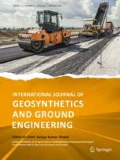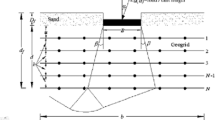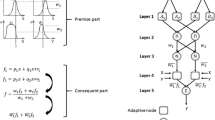Abstract
Extensive laboratory model tests were conducted on a rectangular embedded foundation resting over homogeneous sand bed and subjected to an eccentric load to determine the ultimate bearing capacity. Tests were conducted for foundations with width-to-length ratios (B/L) of zero (strip case), 0.333, 0.5, and 1. The depth of embedment varies from 0 to 1B with an increment of 0.5B; where B is the width of foundation and the eccentricity ratio (e/B) varies from 0 to 0.15 with an increment of 0.05. Based on the laboratory model test results, two different approaches are proposed to determine the ultimate bearing capacity. Firstly, a neural network model is developed to estimate the reduction factor. The reduction factor can be used to estimate the ultimate bearing capacity of an eccentrically loaded foundation from the ultimate bearing capacity of a centrally loaded foundation. A thorough sensitivity analysis was carried out to determine the important parameters affecting the reduction factor. Importance was given to the construction of neural interpretation diagram. Based on this diagram, whether direct or inverse relationships exist between the input and output parameters were determined. Secondly, an adaptive neuro-fuzzy interface system (ANFIS) is used to predict the ultimate bearing capacity. The neuro-fuzzy models combine the transparent, linguistic representation of a fuzzy system with learning ability of artificial neural networks (ANNs). The results from the ANN and ANFIS were compared with the laboratory model test results. It is clearly seen that the performance of the ANFIS model in our study is better than that of the ANN model.






















Similar content being viewed by others
References
Eastwood W (1955) The bearing capacity of eccentrically loaded foundations on sandy soil. Struct Eng 33(6):181–187
Dhillon GS (1961) Settlement, tilt and bearing capacity of footings under central and eccentric loads. J Natl Build Org 6(2):66–78
Lee IK (1965) Foundations subjected to moments. In: Proceedings of the 6th international conference on soil mechanics and foundation engineering, pp 108–112
Michalowski R, You L (1998) Effective width rule in calculations of bearing capacity of shallow footings. Comput Geotech 23(4):237–253
Mahiyar H, Patel AN (2000) Analysis of angle shaped footing under eccentric loading. J Geotech Geoenviron Eng 126(12):1151–1156
Taiebat HA, Carter JP (2002) Bearing capacity of strip and circular foundations on undrained clay subjected to eccentric loads. Géotechnique 52(1):61–64
Meyerhof GG (1953) The bearing capacity of foundations under eccentric and inclined loads. In: Proceedings of the 1st international conference on soil mechanics and foundation engineering, pp 440–449
Prakash S, Saran S (1971) Bearing capacity of eccentrically loaded footings. J Soil Mech Found Div ASCE 97(1):95–103
Purkayastha RD, Char RAN (1977) Stability analysis for eccentrically loaded footings. J Geotech Eng Div ASCE 103(6):647–653
Shahin MA, Jaksa MB, Maier HR (2001) Artificial neural network applications in geotechnical engineering. Aust Geomech 36(1):49–62
Goh ATC (1994) Seismic liquefaction potential assessed by neural network. J Geotech Eng ASCE 120(90):1467–1480
Goh ATC, Kulhawy FH, Chua CG (2005) Bayesian neural network analysis of undrained side resistance of drilled shafts. J Geotech Geoenviron Eng. doi:10.1061/(ASCE)10900241(2005)131:1(84)
Zadeh LA (1965) Fuzzy sets. Inform Control 8(3):338–353
Nayak PC, Sudheer KP, Rangan DM, Ramasastri KS (2004) A neurofuzzy computing technique for modeling hydrological time series. J Hydrol 291(1–2):52–66
Ni SH, Lu PC, Juang CH (1996) A fuzzy neural network approach to evaluation of slope failure potential. J Microcomp Civil Eng 11:59–66
Romo MP, Garcia SR (2003) Neurofuzzy mapping of CPT values into soil dynamic properties. Soil Dyn Earthqk Eng 23(6):473–482
Shahin MA, Maier HR, Jaksa MB (2002) Predicting settlement of shallow foundations using neural network. J Geotech Geoenviron Eng. doi:10.1061/(ASCE)1090-0241(2002)128:9(785)
Shahin MA, Jaksa MB (2005) Neural network prediction of pullout capacity of marquee ground anchors. Comput Geotech 32(3):153–163
Guyon I, Elisseeff A (2003) An introduction to variable and feature selection. J Mach Learn Res 3:1157–1182
Wilby RL, Abrahart RJ, Dawson CW (2003) Detection of conceptual model rainfall-runoff processes inside an artificial neural network. Hydrol Sci 48(2):163–181
Behera RN, Patra CR, Sivakugan N, Das BM (2013) Prediction of ultimate bearing capacity of eccentrically inclined loaded strip footing by ANN part 1. Int J Geotech Eng. doi:10.1179/1938636212Z.00000000012
Garson GD (1991) Interpreting neural-network connection weights. Artif Intell Expert 6(7):47–51
Olden JD, Joy MK, Death RG (2004) An accurate comparison of methods for quantifying variable importance in artificial neural networks using simulated data. J Ecol Model. doi:10.1016/j.eclmodel.2004.03
Ozesmi SL, Ozesmi U (1999) An artificial neural network approach to spatial modeling with inter specific interactions. J Ecol Model. doi:10.1016/S0304-3800(98)00149-5
Ojala T (1995) Neuro-fuzzy systems in control. MSc thesis Tempere University of Technology Tempere Finland
Brown M, Harris C (1994) Neurofuzzy adaptive modeling and control. Prentice-Hall, Englewood Cliffs
Jang J-SR (1993) ANFIS: adaptive network based fuzzy inference system. IEEE Trans Syst Man Cybernet 23(3):665–683
Sugeno M, Kang GT (1988) Structure identification of fuzzy model. Fuzzy Sets Syst 28:15–33
Author information
Authors and Affiliations
Corresponding author
Rights and permissions
About this article
Cite this article
Sethy, B.P., Patra, C.R., Sivakugan, N. et al. Application of ANN and ANFIS for Predicting the Ultimate Bearing Capacity of Eccentrically Loaded Rectangular Foundations. Int. J. of Geosynth. and Ground Eng. 3, 35 (2017). https://doi.org/10.1007/s40891-017-0112-8
Received:
Accepted:
Published:
DOI: https://doi.org/10.1007/s40891-017-0112-8




